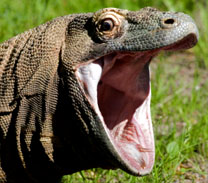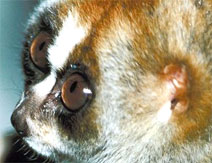|
|
The animals below are all strange for their own reasons... which is your freakiest animal?
|
The pufferfish, also called blowfish and are named for their ability to inflate themselves to several times their normal size by swallowing water or air when threatened. Pufferfish are also one of few kinds of fish that can blink or close their eyes.
Pufferfish also produce a powerful neurotoxin in their internal organs, making them a lethal meal for most predators including humans, yet many humans consider them a delicacy!
Click here to find out more about the pufferfish... |
| |
The Komodo dragon is a huge lizard, growing to an average length of 2-3 meters - 10 feet! In fact, they are the largest living lizard in the world. Komodo dragons are carnivorous.
Although they seem to like carrion (dead animals left by other animals), studies show that they also hunt live prey with a stealthy approach followed by a sudden short charge, during which they can run briefly at speeds up to 20 km/h (13 mph). Click here to learn about their lethal bite...
|
 |
|
Sloths are medium-sized South American mammals that move extremely slowly and only when necessary! They have about half as much muscle tissue as other animals of similar weight.
Their specialized hands and feet have long, curved claws to allow them to hang upside-down from branches without effort. While they sometimes sit on top of branches, they usually eat, sleep, and even give birth hanging from limbs.
Click here to find out more about the sloth... |
| |
Seahorses are true fish though they look very different than most fish.
Many seahorses are mostly transparent - they often don't show up in pictures and even live often people cannot see them at first.
They are notable for being one of only a few species where the males get pregnant.
Click here to learn more about males having babies! |
 |
|
Another prosimian, slow lorises are nocturnal and arboreal animals that prefer the tops of the trees. Like their name states, they are extremely slow.. when they move, they do so with slow, deliberate movements and a powerful grasp that makes them very difficult to remove from branches.
They can produce a toxin in the crook of their elbow that they mix with their saliva. They can then lick the toxin and deliver it using its teeth. Mothers also use it to protect their babies... click here to find out how! |
 |
|
The Bumblebee bat, or perhaps more correctly Kitti's Hog-nosed bat, (is the world's smallest species of bat at 30-40 mm in length. It weighs approximately
2 grams - which is about the weight of a dime!
The skull of the Bumblebee bat, at 11 mm, is smaller than that of any other mammal.
Click here to learn about other bats... |
| |
The platypus is a mammal but a very unusual one - the platypus lays eggs and has a duck-bill - these are not usual mammal traits!
The
males have a venomous spur on the hind foot, baffled naturalists when it was first discovered.
The uniqueness of the platypus makes it a recognizable symbol of Australia; it is featured on the reverse of the Australian 20-cent coin. Click here to learn more about this strange mammal!
|
 |
|
The hoatzin birds are poor fliers, so they have a strange feature to protect them from danger - they have claws at the end of their wings! Young hoatzin have a claws at the ends of their wings, which they use to climb tree trunks and escape from danger.
It's also said that they have a strong connection with dinosaurs!
Click here to learn about other birds...
|
|